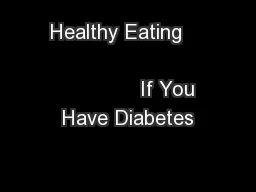PPT-Diabetes Symposium 2015 Power of the Plate: Nutrition and Diabetes
Author : faustina-dinatale | Published Date : 2018-09-18
httpwwwvinafengshuicomwpcontentuploads2014 Presentation Purpose To increase knowledge about identifying carbohydrates carbohydrate counting and portion sizes of
Presentation Embed Code
Download Presentation
Download Presentation The PPT/PDF document "Diabetes Symposium 2015 Power of the Pla..." is the property of its rightful owner. Permission is granted to download and print the materials on this website for personal, non-commercial use only, and to display it on your personal computer provided you do not modify the materials and that you retain all copyright notices contained in the materials. By downloading content from our website, you accept the terms of this agreement.
Diabetes Symposium 2015 Power of the Plate: Nutrition and Diabetes: Transcript
Download Rules Of Document
"Diabetes Symposium 2015 Power of the Plate: Nutrition and Diabetes"The content belongs to its owner. You may download and print it for personal use, without modification, and keep all copyright notices. By downloading, you agree to these terms.
Related Documents














